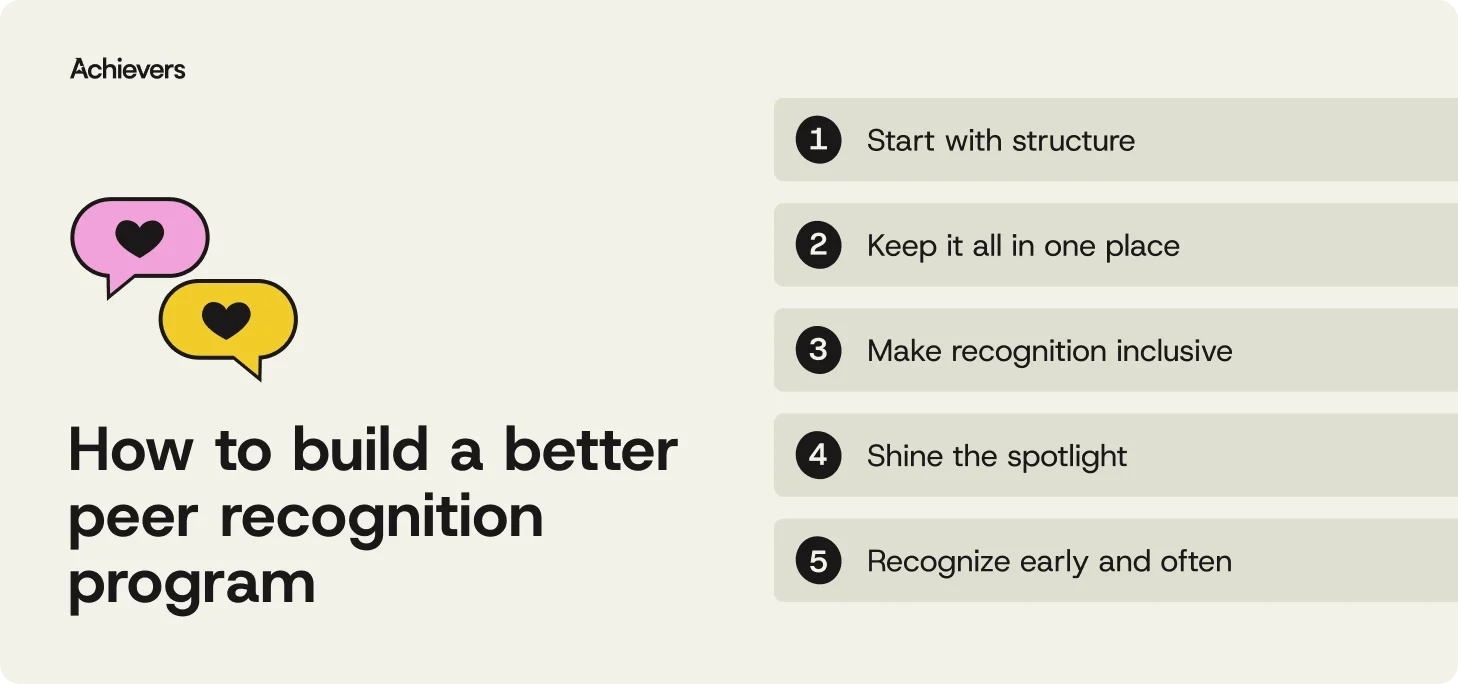Table of contents
Most companies double down on manager-to-employee recognition. Great — until you realize they’re missing a key ingredient: peer recognition. When employees recognize one another, it sparks something bigger than just good vibes. We’re talking stronger engagement, better teamwork, higher productivity, and yes — even fewer “sick days.”
Peers notice the quiet wins and the everyday heroics that managers can’t always see. And when they call it out? It fuels connection, reinforces purpose, and creates a company culture where people actually want to show up and do their best.
In this post, we’ll break down what peer recognition really means, why it matters more than you might think, and share 15 tried-and-true best practices to help your organization create a recognition culture that works—from the ground up.
Ready? Let’s do this.
15 peer-to-peer recognition best practices and ideas
Peer recognition packs a punch — but knowing where to start can feel overwhelming. Here are 15 practical, people-first ways to build a peer recognition program that actually works (and doesn’t gather dust in the HR drawer):

1. Start with structure
Great peer recognition doesn’t happen by accident. It starts with a clear framework. Define what meaningful recognition looks like between peers and set guidelines that make it easy for everyone to join in. From shout-outs to peer-nominated awards, structure makes it easier for recognition to stick — and become part of the everyday workflow within your employee recognition program.
2. Keep it all in one place
If your coworkers need a scavenger hunt to give recognition, something’s off. A single, easy-to-use recognition platform makes peer recognition simple and seamless. It ensures no good deed goes unnoticed, keeps things fair and visible, and makes it easy for peers to celebrate one another without friction or confusion. Fewer clicks. More kudos.
3. Make recognition inclusive
Peers see effort in the details, not just the end results. Build an organizational culture where everyone can recognize and be recognized — not just the extroverts or team leads. Celebrate all types of contributions and review the data to make sure every voice is heard. Real inclusion means every peer has a chance to be seen.
4. Shine the spotlight
Recognition is contagious. Publicly highlighting peer contributions reinforces what good work looks like and shows others that appreciation is part of the team’s DNA. Whether it’s a quick mention in a standup or a company-wide shout-out, public peer recognition creates energy, visibility, and shared pride in your employee engagement strategy.
5. Recognize early and often
Peers notice the day-to-day wins long before performance reviews do. That’s why frequent recognition matters. Encourage regular peer shout-outs for everything from saved deadlines to morale boosts. When recognition becomes a habit, it strengthens relationships and reinforces a positive, people-first workplace culture.
6. Be specific, not vague
When recognizing a peer, skip the “great job” and say what really made a difference. Specificity matters. Call out what they did, why it stood out, and how it helped the team. This makes your recognition more meaningful and helps everyone understand the behaviors worth repeating — a key driver of employee performance.
7. Lead by example
If peer recognition is going to thrive, leaders need to walk the talk. When managers and executives participate in recognizing peers — not just direct reports — it shows that appreciation isn’t about hierarchy; it’s about humanity. The more they model it, the more others will follow across your company culture.
8. Mix social and monetary rewards
Sometimes a peer thank-you says it all. Other times, adding a small reward sweetens the impact. A well-balanced employee reward and recognition program offers both social praise and tangible incentives. Whether it’s a global reward or a coffee voucher, the right mix keeps peer recognition meaningful and motivating.
9. Celebrate the journey
Peers are there for the milestones — big and small. From promotions to personal wins, recognizing those moments helps people feel supported and valued by their teammates. It also reinforces that success is a shared journey, not just a solo destination, and strengthens your employee experience overall.
10. Make it fun
Recognition doesn’t always have to be serious business. Let peers nominate each other for themed awards, run friendly challenges, or keep a kudos leaderboard. A little gamification can supercharge your recognition strategy and keep employees actively participating in a culture of appreciation.
11. Recognize teams and individuals
Peers contribute in different ways — sometimes solo, sometimes as part of a group. Celebrate both. Highlight the collective effort on projects and call out standout individual contributions. When both are recognized, it reinforces that everyone’s role matters and boosts employee morale.
12. Measure what matters
Want to keep peer recognition impactful? Track participation, frequency, and equity. Use data from your recognition platform to see how often peers are recognizing each other and whether it reflects your whole workforce. These insights help improve your employee recognition strategy over time.
13. Let employees nominate peers
Let your people lift each other up. Peer nominations add authenticity to your recognition program and bring hidden contributions into the light. Employees know who’s making a difference behind the scenes — give them a chance to say so through a structured nomination process.
14. Recognize cross-functional wins
Peers often collaborate beyond their immediate teams. When they do, don’t let that work fall through the cracks. Recognize moments where peers from different departments support each other. It breaks down silos and builds a more collaborative employee culture.
15. Link recognition to growth
Peers notice growth before anyone else does. When someone stretches into a new role, learns a new skill, or shows leadership, call it out. Recognizing development supports a growth mindset and reinforces learning as a core part of your employee value proposition.
Peer-to-peer recognition: The stats are in, and they’re impressive
Recent research from Achievers Workforce Institute (AWI), show that peer recognition isn’t just a feel-good gesture — it’s a game changer for engagement, productivity, and retention. These aren’t vanity metrics. They’re proof that a culture of recognition pays off in meaningful, measurable ways. Here’s why:
- It’s happening more than you think: 60% of employees give or receive peer recognition at least monthly. That’s not just a social “like” — it’s a meaningful moment that reinforces what good work looks like.
- It drives connection and belonging: Employees who receive weekly recognition are 9x more likely to strongly agree they feel a sense of belonging at work. Monthly recognition still delivers a 6x lift. If you’re trying to create a more connected culture, this is your starting line.
- It fuels productivity: Workers recognized weekly are 2.6x more likely to say they’re operating at their most productive. That’s not just feel-good — it’s good for business.
- It helps people stick around: Want to improve retention without increasing budgets? Employees who feel meaningfully recognized are nearly 6x more likely to see a long-term future at their company. Recognition doesn’t cost much — but it can save you a ton in turnover.
The takeaway? A culture of recognition isn’t built overnight — but with the right tools, frequency, and intention, it’s entirely within reach. And the results? Undeniably worth it.
Don’t just work together — recognize each other
Peer-to-peer recognition might sound like a soft skill, but the impact is anything but. It boosts engagement, drives productivity, strengthens culture — and helps people feel seen for the work they do every day (not just the big wins). It’s one of the simplest ways to shape a workforce that’s connected, motivated, and built to last.
With Achievers, recognition becomes part of the rhythm of work. Our platform makes it easy for employees to recognize and reward one another in real time — with purpose, meaning, and maybe even a few emojis. From culture campaigns to global rewards, Achievers helps you turn values into behaviors into results.
Ready to build a culture where everyone feels appreciated? You’re in the right place.



